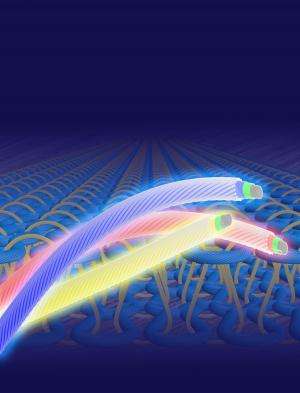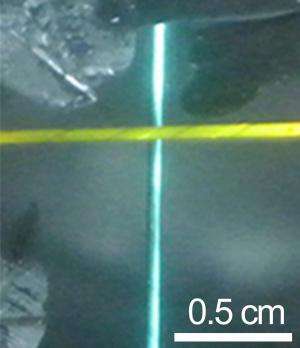March 24, 2015 report
Group creates light-emitting electrochemical cell for use in textiles

A large team of researchers in China has developed a type of light emitting electrochemical cell (LEC) that can be woven into fabric material. As the team notes in their paper published in the journal Nature Photonics, their cells can be used to create wearable electronics. Henk Bolink and Enrique Ortí with the University of Valencia in Spain, offer a News & Views piece on the work done by the team in the same journal issue.
Ever since the development of OLEDs, researchers have been hot on the idea of using them to create wearable electronics, such as clothes that light up like an LED screen. But OLEDs proved too difficult to weave into fiber, which led researchers to LECs, which are essentially OLEDs with salt added to overcome some of the limitations of OLEDs. In this new effort the researchers in China have found a way to create LECs that are both strong enough and flexible enough to allow for weaving into textile fabrics.
To make the LECs, the researchers started with a tiny bare wire, which they coated with zinc oxide nanoparticles; that was followed by applying an electroluminescent polymer and than a transparent layer of carbon nanotubes—the result is a cell that is long, flexible and thin allowing for weaving into fabric. Currently, fabrics created with the cells emit just blue and yellow light (when subjected to just a few volts of electricity) but the team reports it will be a simple matter to add many more colors. The team also reports that the process for making the cells can be ramped up easily, which means the cells, and clothes with them, could be available for sale in the very near future.
There is still one down side, however, the light generated by the cells only persists for a few hours—after that they grow less and less bright. But that problem may be temporary as well, as other ongoing research with LECs suggests that much longer lasting cells may soon be made. If such wearable electronics do become available it could mark a rapid change in clothing, from body suits that show mood by color, to human billboards, to clothes that light up in artistic ways, sort of like glowing tattoos.

More information: A colour-tunable, weavable fibre-shaped polymer light-emitting electrochemical cell, Nature Photonics (2015) DOI: 10.1038/nphoton.2015.37
Abstract
The emergence of wearable electronics and optoelectronics requires the development of devices that are not only highly flexible but can also be woven into textiles to offer a truly integrated solution. Here, we report a colour-tunable, weavable fibre-shaped polymer light-emitting electrochemical cell (PLEC). The fibre-shaped PLEC is fabricated using all-solution-based processes that can be scaled up for practical applications. The design has a coaxial structure comprising a modified metal wire cathode and a conducting aligned carbon nanotube sheet anode, with an electroluminescent polymer layer sandwiched between them. The fibre shape offers unique and promising advantages. For example, the luminance is independent of viewing angle, the fibre-shaped PLEC can provide a variety of different and tunable colours, it is lightweight, flexible and wearable, and it can potentially be woven into light-emitting clothes for the creation of smart fabrics.
Journal information: Nature Photonics
© 2015 Tech Xplore




















